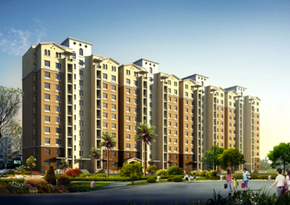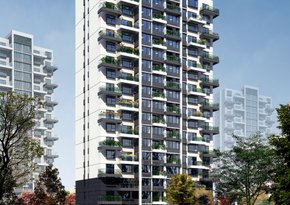
China is one of the fastest growing economies in the world. With this growing economy comes the world´s biggest construction market, ranked number 1 in terms of annual building volume. The sector is so large that by 2015 nearly half of the new buildings annually constructed worldwide will be located in China by 2015.
The rapid urban growth, which is increasing at a tremendous rate, with the urban population rising fivefold in the last 50 years from 107 million in 1960 to 586 million in 2009 (Yifel 2012) is partially responsible for this construction boom. Existing building area in 2010 being at 48,6 billion m2 and the rate of new construction at ca. 2 million m2/a
The residential sector is the largest of the building sector, with 60 % of all new buildings; this is followed by the public and commercial sector with 30% and the industrial sector with 10%. As growth in household wealth has increased there has been a significant market growth for new residential buildings as well as the appliances market including the energy consumption increase that goes with it. The rapid transformation and post industrialization that China is currently undergoing has also led to the demand for office buildings in the service sector rising dramatically. With these offices buildings also comes an increased demand for energy for thermal building conditioning. Between 1996 and 2008 total floor space (in urban areas) in northern China has tripled from three billion to nine billon square meters.
This rise in demand for energy makes the building sector the most significant driver in overall energy consumption. The construction market will by 2020 account for 40% of the country’s total energy consumption. It was estimated that the Chinese building sector consumed 373 million tons of oil equivalent (Mtoe) in 2005 or about 14% of total global building energy use. Of this It was estimated that the residential sector was responsible for 90% of building energy consumption. (IEA 2007). This is approximately 28 per cent of the country’s total energy consumption (UNDP 2010). Energy demand in China will maintain high growth in the future as more buildings are built.
At present although the focus in the building sector is more on that of green buildings, energy efficient buildings play an important yet slightly lesser role. However energy efficient building in China cannot be seen as being separate from green buildings in China but rather as complimentary.
Despite this China has achieved significant progress in improving building energy efficiency over the last two decades, much of which can be attributed to carefully planned development strategies, and strong and consistent support from the central government.
The Strategic Approach is a worldwide valid recommendation for energy consumption levels. A Strategic Approach to integrated building design is the key to achieving high-energy savings at low or no extra cost in residential buildings. bigEE recommends using this Strategic Approach for energy efficiency in buildings.

The following table lists the energy consumption ranges as set by bigEE to achieve LEB, ULEB and nZEB/PLEB. (Note: For climate zone definitions for China please read the Climate text under Overview)
| Cold (e.g. Qinghai) | Temperate (e.g. Beijing, Shanghai) | Hot and Humid (e.g. Shenzhen) | Hot and Arid | |
|---|---|---|---|---|
| kWh/m2TFAyr | kWh/m2TFAyr | kWh/m2TFAyr | kWh/m2TFAyr | |
| LEB | 40 – 80 | 40 – 80 | 100 – 150 | 50 – 100 |
| ULEB | 20 – 40 | 20 – 40 | 50 – 100 | 25 – 50 |
| nZEB | 0 – 20 | 0 – 20 | 0 – 50 | 0 – 25 |
| PEB | ++ | ++ | ++ | ++ |
For detailed information on the Strategic Approach please see the Strategic Approach text of the Interactive Buildings Guide more ...
The following table lists the provincial capitols of China and their corresponding climatic zones according to the Strategic Approach of bigEE
| City | HDD18°C | CDD10°C | Humidity (warmest month) % | bigEE Climate |
|---|---|---|---|---|
| Beijing | 3035 | 2164 | 76 | Temperate |
| Changchun | 4719 | 1537 | 53 | Temperateæ |
| Changsha | 1598 | 3047 | 74 | Temperate |
| Chengdu | 1574 | 2590 | 84 | Temperate |
| Chongqing | 1303 | 2917 | 74 | Temperate |
| Dongguan | 405 | 4437 | 80 | Hot and Humid |
| Fuzhou | 835 | 3583 | 76 | Hot and Humid |
| Guangzhou | 446 | 4328 | 79 | Hot and Humid |
| Guiyang | 1979 | 2270 | 77 | Temperate |
| Haikou | 121 | 5016 | 84 | Hot and Humid |
| Hangzhou | 1220 | 2781 | 78 | Temperate |
| Harbin | 5804 | 1254 | 58 | Temperate |
| Hefei | 1983 | 2650 | 82 | Temperate |
| Hohhot | 5081 | 1221 | 97 | Temperate |
| Jinan | 2405 | 2656 | 69 | Temperate |
| Kunming | 1487 | 1871 | 65 | Temperate |
| Lanzhou | 3521 | 1504 | 63 | Temperateæ |
| Lhasa | 3826 | 652 | 54 | Cold |
| Nanchang | 1514 | 3141 | 76 | Temperate |
| Nanjing | 2016 | 2641 | 81 | Temperate |
| Nanning | 615 | 4325 | 95 | Hot and Humid |
| Qingdao | 2653 | 1981 | 81 | Temperate |
| Shanghai | 1925 | 2681 | 82 | Temperate |
| Shantou | 455 | 4089 | 84 | Hot and Humid |
| Shenyang | 4139 | 1760 | 80 | Temperate |
| Shenzhen | 239 | 4909 | 26,7 | Hot and Humid |
| Shijiazhuang | 2652 | 2416 | 59 | Temperate |
| Taiyuan | 3504 | 1679 | 89 | Temperate |
| Tianjin | 2995 | 2232 | 75 | Temperate |
| Ùrumqi | 3764 | 2311 | 49 | Temperateæ |
| Wuhan | 1662 | 3033 | 79 | Temperate |
| Wuxi | 1988 | 2586 | 82 | Temperate |
| Xi'an | 2521 | 2262 | 63 | Temperate |
| Xining | 3503 | 1498 | 63 | Temperateæ |
| Yinchuan | 3824 | 1604 | 63 | Temperate |
| Zhengzhou | 2352 | 2512 | 63 | Temperate |
This systematic tool, will allow you to browse a list of strategies and recommendations, for building energy efficient buildings, in the four major world climates and types of building that might be of interest to you. Please choose a Climate Zone, State, Mode and Building Type to see our Recommendations on achieving LEB. ULEB and nZEB/PEB buildings.
Explore worldwide recommendations in the bigEE Buildings Guide
Here you can find examples of holistically planned and energy efficient Good Practice Buildings in China. These Good Practice Building examples provide essential information at a glance (key information including climate zone, building typology and primary energy consumption) and show detailed descriptions upon choosing any particular example (detailed description including passive architectural features, construction, techniques and technologies used as well as any special features and energy cost savings).
For Good Practice Building examples worldwide please go to the Interactive Buildings Guide Good Practice Page more ...

| Year | 2009 |
| Location | Ürumqi, China |
| Area (TFA) | 15580 m2 |
| Dwellings | 175 |
| Cost | 249 EUR/m2 |
| Consumption | 18.4 kWh/m2/year (primary energy) |

| Year | 2012 |
| Location | China |
| Area (TFA) | 5112 m2 |
| Dwellings | 54 |
| Cost | 138 EUR/m2 |
| Consumption | 23.7 kWh/m2/year (primary energy) |

| Year | 2013 |
| Location | Changxing, China |
| Area (TFA) | 2200 m2 |
| Dwellings | 46 |
| Cost | None EUR/m2 |
| Consumption | 93.4 kWh/m2/year (primary energy) |